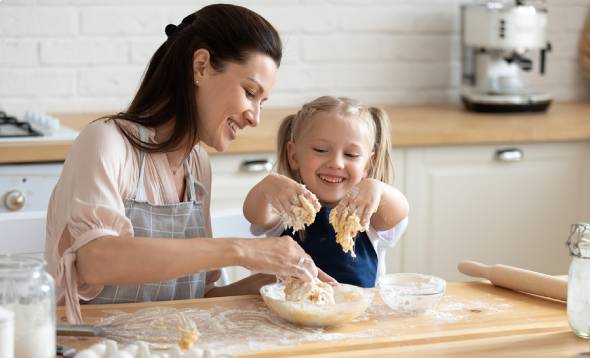That organic living is a conscious health choice
Making the Most of Kids Stay-Home Meals
As it is, planning meals for kids during regular times requires a certain degree of logistics. Parents must navigate differing taste preferences, special dietary needs, activity schedules, grocery shopping – not to mention the meal prep itself.
This task can feel doubly challenging given the current situation. Favourite go-to foods may be unavailable, much to the disappointment of picky eaters. With reduced physical activities and outdoor time, little ones may be less apt to sit still and remain at the table. Meals can feel like ‘one more thing’ for parents to check off their never-ending task list, amidst added home-schooling responsibilities and overall peacekeeping at home.
Without too much time and effort, it’s possible to boost engagement, overcome variable moods, integrate learning and even create a spirit of play within the kitchen or at the dining table.
Here are a few ideas to make the most of your child’s at-home meals in the weeks ahead:
PARTICIPATION
Right now, kids may be more open to doing anything new and different. So, if they haven’t been heavily involved with meal-related tasks, this might be a good time to begin. This can alleviate responsibilities previously shouldered by parents. Likewise, when children feel familiar and engaged with their meal, they’re also more likely to eat it – an added bonus for parents managing little ones with picky palates.
What food-related to-do items can you assign or share with your kids?
- Ask them to survey the stock in the pantry and the refrigerator, and start an initial grocery list.
- Invite them to sit with you while you order your groceries online and talk them through the process.
- Work together to put the new groceries away when they arrive and teach them where each item belongs in the kitchen.
- Include them in meal prep – whether it’s washing fresh produce, stirring the stew, measuring ingredients or simply setting the timer.
- Give them the job of setting and clearing the table.
EDUCATION
Mealtimes can also be an opportunity to let the little ones learn – especially when daycare is closed or school-time is reduced. This can be a casual conversation about how to recognise and spell each ingredient, the origins of the ingredients or the recipe, how long it takes to grow a certain crop or the nutritional benefits of specific foods.
Parents can task older children to search for this information online and do a mini presentation for the rest of the family. Many books and videos cover these topics and other food-focused subject as well. Parents can watch the videos or read along with kids, and then work with them to plan a meal to match the story.
PRESENTATION
Like adults, children eat with their eyes. When a meal or a dining environment looks familiar, intriguing or inviting, kids are more likely to accept and enjoy whatever they’re served. Again, this may mean a few extra steps on the part of parents. However, it can also be a joint effort. A few suggestions include:
- Making everything miniature. Kids tend to identify with and therefore appreciate edibles that are sized smaller – just like them. Simply preparing petite versions of muffins, pancakes, biscuits or burgers can make the difference between a winning meal and an outright food refusal.
- Being playful. Cutting foods into recognisable shapes – like hearts, flowers, clouds or the sun – or simply making a smiley face out of pancakes, pizza or porridge toppings can add an element of fun to a child’s plate.
• Working the room. Ambience matters to kids too. Get them to adjust the lights, pick the background tunes, choose the table setting or even select a new spot within the house to hold the family meal. A bit of variety can help switch up the ordinary and add some joy to our current stay-home circumstances.
IMITATION
Many of their favourite cafes remain closed. With supermarkets short on supplies, some of their coveted must-haves aren’t available. This is just as disappointing for them as it is for adults – especially for children with narrow food repertoires. How do we ‘make do’? Consider attempting DIY versions of the dishes – such as homemade breads, French fries, granola, meatballs, waffles or sushi - that your kids like to order when dining out.


























_1672804154.jpg)

_1611290459.jpg)